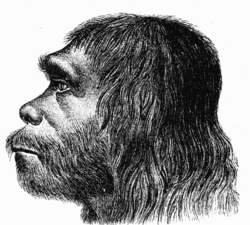New genetic analysis of Neandertal populations over the last 100 thousands years shows an interesting dynamic: the variability is high until about 50 KYA years and then suddenly contracts, sharply:
(UPI) — Scientists said a study of ancient DNA indicates most Neanderthals in Europe died off as early as 50,000 years ago, leaving only a small group that re-colonized central and western Europe and survived for another 10,000 years before modern humans arrived on the scene. “The fact that Neanderthals in Europe were nearly extinct, but then recovered, and that all this took place long before they came into contact with modern humans came as a complete surprise to us,” Love Dalen at the Swedish Museum of Natural History in Stockholm said.
Neandertals (most paleo-anthropologists I’ve met with do not use the “h” at the end of the name and often used the abbreviated term, neanders, to refer to them) were a subspecies of humans with a suite of clear morphological distinctions common to southern Europe and parts of Asia from about 250,000 years ago to about 40,000 years ago. They likely descend from the clade H. heidelbergensis that colonized Eurasia beginning as much as half a million years ago. Beginning a little over 50,000 years ago, anatomically modern humans appear in the Middle East and flow into Europe, where they clearly would have encountered classic neander strongholds. Within ten thousand years neanders are gone, and they seem to disappear from east to west across Europe, right as modern humans were moving in from the Middle East and moved west toward modern-day France and Spain. The big question is why, what happened, did modern people out compete the neanders, or perhaps absorb them into our lineage? It’s a fascinating question …
There are abrupt climatic changes happening all through this time period, even a super volcano about 70,000 years ago in Indonesia that could have had a dramatic effect on our direct ancestors in Africa. But nothing truly huge jumps out climate wise 50,000 years ago, beyond the same kind of crazy jigs and jags that had been going on for millennia before and after.
One thing bugged me about this story. I haven’t read the original paper yet, so maybe I’m missing something important. But all across the traditional and new media world at least half the articles on it lead with something like “Modern humans not at fault for wiping out Neanderthals, they were already going extinct.” And yet that is not what the text below those same headers seems to be saying. What I’m reading therein is the new analysis shows a measurable drop in genetic variation in one region, one consistent with a drop in population, followed by a recovery with far less variation consistent with a small group of survivors or outsiders moving into the vacuum successfully. (That decrease in genetic variation could conceivably leave the neander survivors less robust as a deme; in particular they might have fewer alleles for selection to work on in the event a new disease or diseases were introduced by the encroaching modern humans.) It certainly doesn’t spare us a role in what happened next.
Neandertals weathered the most extreme, unpredictable environments ever faced by any known hominid species up to that time, and they did it for something like 200,000 years — which incidentally is two times longer than anatomically modern humans have existed. If anything this info suggests they had a knack for surviving, thriving, and even repopulating regions periodically locked for decades or centuries in a bitter icy embrace. But despite the headlines shouting out our acquittal, it does little to explain why that ongoing recovery was stopped cold in its tracks, or why such a hardy, successful species went the way of the dodo after modern humans arrived. What do you think?


What has happened to every creature (including ethnologically different and/or technologically deficient humans) that has hampered our expansion into new territory?
I’m definately a proponent of the multi-regional school rather than the recent out of Africa school; Wolpoff has always argued that the numbers of neandertals was small relative modern humans (HS sapiens v HS neandertalus). The most likely explanation is that the larger HS sapiens population absorbed the neandertal, and is reflected in estimates of how much of the Neanderthals genome survives (1 to 4 percent) with larger numbers in Europe.
They were likely annoyed to death.
By a species which does things like change the spelling of a word that people are too idiotic to pronounce correctly. Germany didn’t normalize spellings outside of its boundaries, plus, it’s a proper name (twice over). Might as well call it Neumann Valley hominid. But the scientific name isn’t going to change to remove the h from neanderthalensis, anyway.
It’s just lame without an h. Thalweg without an h would be awful, but if the spelling-improvers have their way, we’ll end up with talveg. And some jackass will want to pronounce that with a soft g and the wrong a.
So my guess is that the Neanderthals would say, “There goes the neighborhood”, and leap off the nearest cliff.
Hear! Hear! F :-) Poor H sapiens neanderthalensis and they were so much less repetitive than we H sapiens sapiens (I’ve always felt that that repetition indicates a, probebly deserved, lack of confidence).
Oh! Yes! And I definitely don’t want meat and talveg.
@ me: Can’t tpye todey!
Do please add a colon after neanderthalensis and substitute a more conventional spelling for ‘probably’
[Smiles, hops in his white Ford Bronco, sets off to find the ‘real’ killer.]
Sounds as though some Cro-Magnon slut went north and spread some vd that the Neaners had no defense against. Or I’ve been in public health too long.
KYA? Kiss your own!